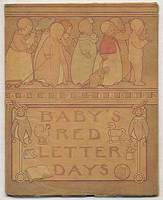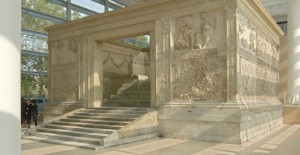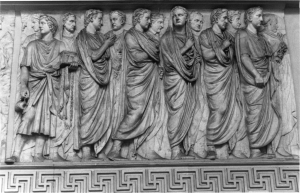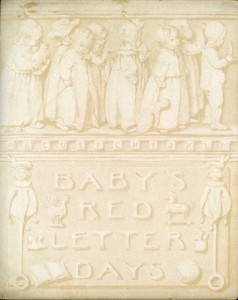
Jessie Willcox Smith (1863-1935)|Cover design for booklet, Baby’s Red Letter Days, 1901(l) and 1906 (r)|Produced by Just's Food Co., Syracuse, N.Y.
While perusing an interesting website recently (https://ephemerastudies.org/), I noticed this cover for a baby book designed by Jessie Willcox Smith.* The cover illustration is composed of an upper and lower image separated by lines delineating moldings above and below a series of square blocks, whose faces are marked with the alphabet sequence A through N. The lower half of the cover reveals the booklet’s title, Baby’s Red Letter Days, bracketed at right and left by long handled baby rattles decorated to look like children wearing hats and jumpsuits adorned with bells. At either side of each words, “red / letter / days” are illustrations of children’s toys, clothing, or a book (a rooster; a pull horse; boots; a jack-in-the-box; an open book; a ball). The upper half of the cover is illustrated with a frieze of young children moving from the left to the right.
The company originally sent copies of these books to physicians. They were intended to be presented by the doctor to the parents with the advent of a child’s birth. This booklet is listed in The School Arts Book** (volumes published in 1905 and 06) “solely because of its artistic merit” and according to that listing was also available by sending the name of your family physician and twenty-five cents to the company. These baby books were meant to be filled out by a child’s parents as a record of the child’s development. The earlier version of the cover image was printed in beige tones and the illustration embossed on the heavy paper. These baby books, produced by Just’s Food Company, were the first and only appearance of these JWS illustrations. This booklet was reissued in 1906 with the covers colored in light orange, blue, and yellow.
The division of this cover design into top and bottom halves coupled with the frieze of children moving from the left to the right reminded me of the sculptural frieze above and decorative panels below created to decorate the Ara Pacis Augustae, (13-9 BC) the altar to Peace commissioned by the Roman Senate to honor emperor Augustus’ triumphal return from Hispania and Gaul (see below).
The Ara Pacis upper frieze depicts the Emperor and his extended family walking together on their way to offering sacrifices to the gods. As the mass of Romans move toward the altar they are shown relating to others moving along with them, some of their feet lift from their heels, others slip over the edge of the frieze protruding into contemporary space. Jessie Willcox Smith used some of these same conventions to express the relationship of the individual children in her frieze to one another. The groupings clump up or shift apart so that they too look as a natural gathering as they move through the spatial construct of the image. Their clothing (from head coverings to rompers) reveal the variety of children’s nightwear typical around the turn of the century. If you look carefully at them you will notice a variety of popular children’s toys: pull toys, dolls, and even a child blowing a horn.
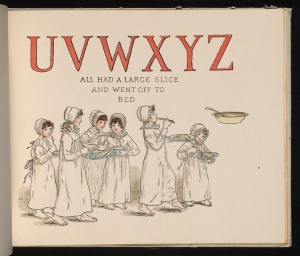
I was also reminded of some of Kate Greenaway’s A Apple Pie*** illustrations created to accompany her alphabet book. Smith’s and Greenaway’s images are reminiscent of one another both in the use of toys that accompany the children, and in the representations of children ready for bed. Not only did Greenaway use a frieze of figures to accompany the rhyme, she also used the frieze to move the story line through the book. I would think that Jessie Willcox Smith used the frieze to also move along the concept of a book of days. As the days pass, people (or in this case other children) move in and out of a child’s life. So while Smith’s children may not be moving toward a public altar or their civic duty at this stage in their lives, all children move in and through their community and into their adult lives from their childhood experiences.
* My thanks to Saul Zalesch, Louisiana Tech University, Ruston, LA for gathering and making accessible a variety of American ephemera.
** Henry Turner Bailey, ed. The School Arts Book v. 5 (September 1905-June 1906): 672 .
*** A Apple Pie, illustrated by Kate Greenaway (London: George Routledge & Sons, 1886)
December 2, 2010
By Joyce K. Schiller
Curator, Rockwell Center for American Visual Studies
Norman Rockwell Museum


